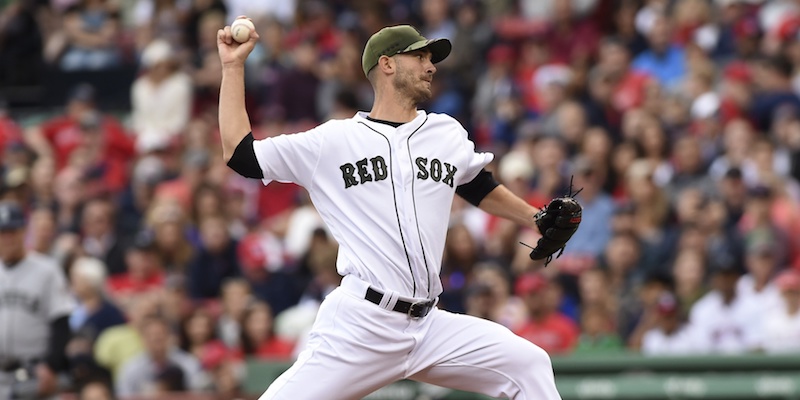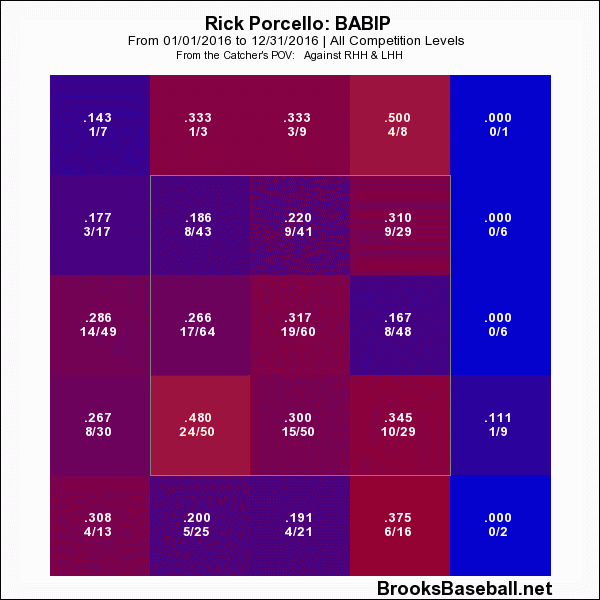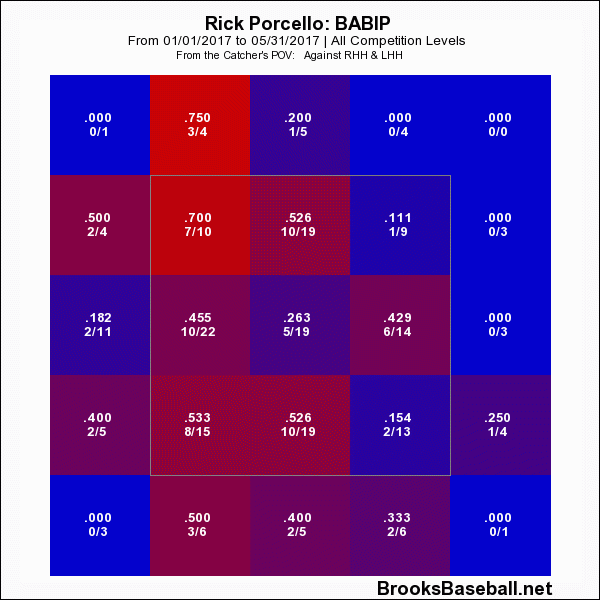Last year, we saw Rick Porcello at what was probably the peak of his career. A crazy-good second half finished an insanely good year for him, and one that got him the AL Cy Young award. Naturally, expectations were high coming into 2017, even with Chris Sale taking a lot of the attention off of him. So far, however, Porcello hasn’t been close to what we saw in 2016. Now I’m not saying that I expected a repeat of what he did, but maybe a lesser version. We’ve seen no such thing – Rick Porcello has just been okay. Nothing spectacular, but you’d hesitate a bit before calling him a solid pitcher.
So here we sit, 51 games in, and Porcello’s ERA and DRA both sit at 4.21. His FIP sits at 3.56, which is nice, but it still doesn’t hand-wave away how forgettable he’s been. There’s a lot of peripherals we can look at, but the first and most notable thing that’s risen is the homers. His HR/9 is 1.32 which is mediocre at best, and his HR/FB rate rose two percentage points. That seems bad, but it also requires context. The 9.3 percent HR/FB rate he had last year was a career-low, and while the HR/9 wasn’t, it was still pretty good despite all the fly balls he was giving up. In fact, the HR/FB rate has just regressed to his career average of 11.2 percent. Problem is, he’s allowing more fly balls than ever, so the number of home runs is bound to increase. It’s not something that looks like it’ll change for the better anytime soon, barring a drastic change in his batted ball rates.
Since the stuff that’s going out of play isn’t looking like it’s going to get better anytime soon, let’s look at the stuff that’s staying in the park. Last year, Porcello’s BABIP was a low .269. He allowed a line drive rate of 18.9 percent, and conjured up a infield fly on nearly 14 percent of all contact. That somewhat supported it, but there wasn’t a huge difference in anything we can see as quantifiable – velocity, movement, nothing. He lived in the zone more (hence the sharp drop in walks), and despite no notable increase in anything, got spectacular results. Here’s what his strike zone looked by BABIP in 2016:
There’s quite a lot of .300 or lower marks in there, which is pretty good for pitches in the zone.
In 2017, however, it’s a lot more rough for Porcello.
Yeesh. Tons of high BABIP marks in there, including that glaring .700 on the high inside corner.
Porcello is allowing more liners this season, and for the first time in his career, his fly ball rate exceeds his ground ball rate. Hitters are getting much better contact this time around, and we’ve seen a whopping 12.5 percent jump in his hard hit percentage from 2016. He’s allowing more hard contact than medium contact, and that’s a little scary. Batters just aren’t missing or making weak contact against stuff in the zone anymore.
All of what you’ve just read has combined to give Porcello a .370 BABIP. That’s unquestionably bad, and raises some questions. Could it be because of the defense? Well, third base aside, the defense hasn’t really been worse than the 2016 squad’s. Mitch Moreland is an improvement over Hanley Ramirez, Dustin Pedroia and Xander Bogaerts are still solid up the middle, and the outfield boasts three plus defenders. So it’s probably not because of the defense. Are they making more contact? No, but the quality of the contact has been better, so that’ll spike it a little.
It all comes back to how often he’s going to throw in the zone. Porcello’s been locating his pitches in the zone at a career-high 51 percent this year, and while that sounds great, it also lends to more hits, since batters are going to be seeing more hittable pitches. It keeps the walks down, sure, but even with the increased strike-throwing efficiency, Porcello’s still going to be throwing stuff in the zone that’s not exactly blowing people away, signature two-seamer notwithstanding. 88 hits in 68.1 innings isn’t pretty, no matter how many strikes you throw.
What might be changing in a different sort of way is that Porcello might be changing what type of pitcher he is. Normally, you’d think of him as a guy who gets a lot of grounders, strikes out a moderate amount of guys, and won’t really hurt you. Now, he’s striking out 22.4 of batters – a career-high – and still walking less than five percent of all batters faced. It’s a different Porcello than we expected when Ben Cherington gave him an extension in 2015, and it comes with its own pros and cons. Strikeouts are good, but they’re coming at the expense of his batted ball profile, which has gone in a bad direction for a Fenway-based pitcher. The quality of his starts is going to fluctuate, since he’ll strike out a fair few, but the contact will range from “screaming rockets” to “slow bouncer to short”.
Porcello will get better this season. He’s regressed, but he’s not this bad, and he’s definitely not going to allow a .370 BABIP for four more months. Expecting a year like 2016 to happen again was probably a foolish endeavor, but he’s not going to bottom out in 2017. For all the hard contact he’s allowed, he hasn’t turned into a pumpkin just yet. He might just be turning into a strikeout pitcher, and we’re seeing a short, errant uptick in hits until he really bores down. No one really knows. It’s just tough to look forward and see good times ahead when there are a few warning signs. Porcello has more than earned that extension, but it remains to be seen how it’ll all end.
Photo by Bob DeChiara – USA TODAY Sports



Interesting and illuminating, as always. The BABIP giveth and the BABIP taketh away. Will be interesting, as you note, to see if there is a true change in Porcello’s approach and if there is, how it plays out.